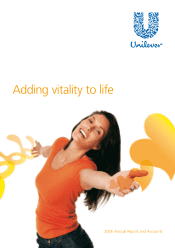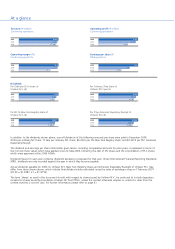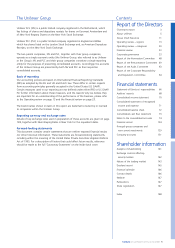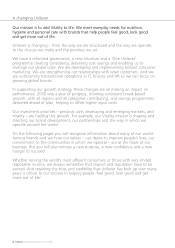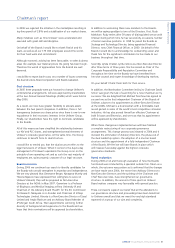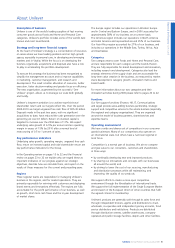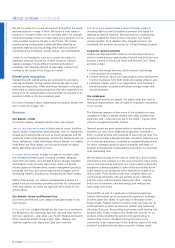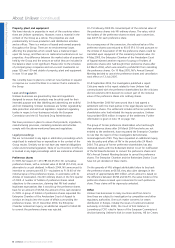Unilever 2006 Annual Report Download - page 8
Download and view the complete annual report
Please find page 8 of the 2006 Unilever annual report below. You can navigate through the pages in the report by either clicking on the pages listed below, or by using the keyword search tool below to find specific information within the annual report.
Unilever Annual Report and Accounts 2006 5
Report of the Directors (continued)
About Unilever
Description of business
Unilever is one of the world’s leading suppliers of fast moving
consumer goods across Foods and Home and Personal Care
categories. Unilever’s portfolio includes some of the world’s best
known and most loved brands.
Strategy and long-term financial targets
At the heart of Unilever's strategy is a concentration of resources
on areas where we have leading positions and on high growth
spaces, especially in personal care, in developing and emerging
markets and in Vitality. While the focus is on developing the
business organically, acquisitions and disposals also have a role
to play in accelerating the portfolio development.
To execute this strategy the business has been reorganised to
simplify the management structure and to improve capabilities
in marketing, customer management, and research and
development. The result is better allocation of resources, better
execution, faster decision-making and greater focus on efficiency.
The new organisation, augmented by the successful 'One
Unilever' project, allows us to leverage our scale both globally
and locally.
Unilever's long-term ambition is to achieve top-third total
shareholder return and our targets reflect this. Over the period
2005-2010 we target ungeared free cash flow of €25-30 billion.
Disposals made in the past two years, with no significant
acquisitions to date, have reduced the cash generation over the
period by just over €1 billion. Return on invested capital is
targeted to increase over the 2004 base of 11%. We expect
underlying sales growth of 3-5% per annum and an operating
margin in excess of 15% by 2010 after a normal level of
restructuring of 0.5 to 1 percent of sales.
Key performance indicators
Underlying sales growth, operating margin, ungeared free cash
flow, return on invested capital and total shareholder return are
key performance indicators for the Group.
In the Operating review on pages 13 to 22 and the Financial
review on pages 23 to 32 we explain why we regard these as
important indicators of our progress against our strategic
objectives, describe how we calculate them, and report on the
results of these measures for the current and preceding years.
Regions
Three regional teams are responsible for managing Unilever’s
business in the regions, and for market operations. They are
primarily responsible for winning with customers and deploying
brand events and innovations effectively.The regions are fully
accountable for the profit performance of our business, as well
as growth, short-term cash flows and the in-year development
of market shares.
The Europe region includes our operations in Western Europe
and in Central and Eastern Europe, and in 2006 accounted for
approximately 38% of our business on a turnover basis.
The Americas region includes our operations in North America
and Latin America and represented around 35% of our business.
Our Asia Africa region accounted for 27% of our business, and
includes our operations in the Middle East, Turkey, Africa, Asia
and Australasia.
Categories
Two category teams cover Foods and Home and Personal Care,
and are responsible for each category and the brands therein.
They are fully responsible for brand development and innovation,
including research and development. Categories also lead the
strategic elements of the supply chain and are accountable for
long-term value creation in the business, as measured by market
share development, category growth, innovation metrics and
brand health.
For moreinformation about our two categories and their
innovation activities during 2006 please refer to pages 20 to 22.
Functions
Our five support functions (Finance, HR, IT, Communications
and Legal) provide value-adding business partnership, strategic
support and competitive services to the whole business (especially
the regional and category organisations). They are organised
around the model of business partners, shared services and
expertise teams.
Operating environment
Wehave a wide and diverse set of competitors in our consumer
goods businesses. Many of our competitors also operate on
an international scale, but others have a narrower regional or
local focus.
Competition is a normal part of business. We aim to compete
and give value to our consumers, customers and shareholders
in three ways:
• by continually developing new and improved products;
• by sharing our innovations and concepts with our businesses
all around the world; and
• by striving to lower the cost of our sourcing, manufacturing
and distribution processes while still maintaining, and
improving, the quality of our products.
Wesupport efforts to create a more open competitive
environment through the liberalisation of international trade.
Wesupport the full implementation of the Single European Market
and inclusion in the European Union of other countries that fulfil
the agreed criteria for membership.
Unilever’sproducts aregenerally sold through its sales force and
through independent brokers, agents and distributors to chain,
wholesale, co-operative and independent grocery accounts, food
service distributors and institutions. Products are distributed
through distribution centres, satellite warehouses, company-
operated and public storage facilities, depots and other facilities.


